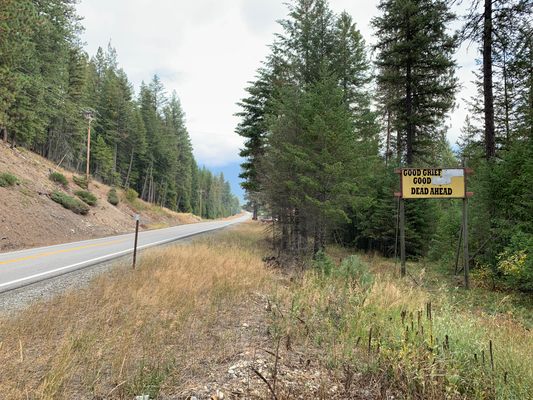About
In the mid-1950s, husband and wife Lou Paul Spring and Geraldine Spring (known as Paul and Gerry) bought a small remote building in Idaho, less than four miles from the Canadian border, and remodeled it into a tavern. Legend has it that Paul bought it without consulting Gerry, and when she heard about it, she exclaimed "Good Grief!"—and a name was born.
But as is often the case, that legend is wrong. In reality, the pair had been running the tavern for several weeks together before they figured out a name. One of their beer delivery drivers always said "good grief" when he walked through the door—according to some, because of the bad quality of the road on the Idaho side of the border compared to the Canadian side. The couple's love of the comic strip Peanuts, with Charlie Brown's famous "Good Grief!" catchphrase, solidified their decision to use this as a name.
By 1962, local newspapers began paying attention to the sign Paul had put up by the road: "Entering Good Grief, Idaho: Pop. 3 people, 2 dogs, 1 old grouch". The three people were Paul, Gerry, and Gerry's mother, Eva Mae Lorge. The old grouch was Paul, but only "on occasion," according to Gerry. Good Grief received national attention in January 1974 when it was given a shout-out on the variety show Hee Haw. The show had a recurring segment where a random small American town was "saluted," with its name and population called out. Good Grief's catchphrase was too amusing a population figure to not use, even though by then it had been rendered outdated: Eva Mae had died the previous year, leaving just two people.
Paul and Gerry put the tavern (and by extension the town) up for sale in July 1974, just as the attention started bringing in a trickle of newcomers looking for a quiet rural life. The iconic sign was replaced by one that read "Population: Increasing." New residents included the novelist Denis Johnson, as well as Marie and Richard Villelli, who built tucked into the woods the largest log cabin in the country as their personal home. In 1979, Chuck Bianchi, another newcomer, recorded a song about the town called "Good Grief Breakdown," which sold about 1,000 copies, mostly in neighboring British Columbia. By the early 1990s, about 150 people lived in the general area, although it's been debated just how many of them truly live in Good Grief, since they reside scattered throughout the forest.
The central Good Grief store has had a number of owners over the years, and at times has sat closed. It was nonoperational between 1997 and 1999, and again from 2009 to 2019. The current owners, Stanislav and Svetlana Fedoseyev, have put up a replica of the original sign, once again declaring the population as "3 people, 2 dogs, and 1 old grouch." If the town's borders only encompass the store and its immediate area, like many say, then the sign isn't too far off.
Related Tags
Community Contributors
Added By
Published
November 25, 2024
Sources
- https://www.youtube.com/watch?v=lsh9NxDJ8uU
- "Good Grief---It's Quiet." Spokane Chronicle, December 3, 1962.
- "Mrs. Eva Mae Lorge." Bonners Ferry Herald, June 28, 1973.
- "Seen and Heard ..." Bonners Ferry Herald, January 31, 1974.
- "Real Estate." Bonners Ferry Herald, July 18, 1974.
- Donahue, Michael. "Ex-Memphian Tells of Good Grief Living." Memphis Press-Scimitar, August 15, 1980.
- Burwell, Roger. "Finally, a Sensible Statement on the Bypass." Bonner County Daily Bee, January 6, 1988.
- Werner, Marlene. "No Cabin Fever in This Log Home." New York Times, April 28, 1988.
- Woodward, Tim. "Good Grief! They Sure Are Proud to Live in Idaho." Idaho Statesman, June 23, 1990.
- Peters, Martha. "Looks Like Open Season on Good Reading This Fall." El Paso Times, July 29, 1990.
- "Lou Spring, 78." Bonners Ferry Herald, July 31, 1991.
- Free, Cathy. "Good Grief, Quaint Town Is Discovered!" Spokesman-Review, June 27, 1993.
- Etlinger, Charles. "Good Grief! It Really Is a Tiny Place in Northern Idaho." Idaho Statesman, November 8, 1999.
- Allsop, Dani, and Brian Holmes. "How the 1970s Sitcom 'Hee Haw' Put the Town of Good Grief, Idaho on the Map." KTVB, March 2, 2020. https://web.archive.org/web/20200303212017/https://www.ktvb.com/article/news/local/208/history-of-goof-grief-idaho-small-town/277-5a8ebf77-6f0f-43d8-bffb-e29cfd53cf8e

























